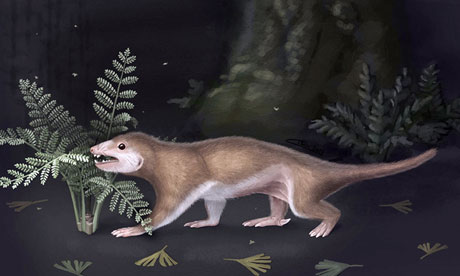Source: The Guardian
Jurassic squirrel's secret is out after 165m years
Ian Sample, science correspondent
The Guardian, Wednesday 7 August 2013 19.28 BST
The discovery of a small furry beast from the Jurassic era has given scientists fresh insights into the evolution of the first mammals on Earth. The fossilised remains of the squirrel-sized animal that plodded rather than scampered, came from rock dated to 165m years ago, when feathered dinosaurs shared the land.
Named Megaconus, or "large cusp", after its distinctive teeth, the animal was unearthed in Inner Mongolia where it had been preserved in volcanic ash that settled in a freshwater lake. It is thought to be an early relative of mammals, and has some mammalian features, while others are more commonly seen in reptiles.
Preserved among the remnants is evidence of fur and a keratinous spur that jutted from the hind ankle and was probably used to deliver poison to predators. The bones of its middle ear were more primitive, and attached to the jaw as in reptiles. The discovery shows that animals evolved to have fur before the first true mammals emerged. The fur was primarily for insulation, but may also have served a sensory purpose.
The animal belongs to a group called the haramiyids, whose existence was previously based on the scant fossil evidence of isolated teeth. Megaconus had long, rodent-like teeth able to chew plants and munch on insects and worms.
-snip-
Read more: http://www.theguardian.com/science/2...volution-earth





 Reply With Quote
Reply With Quote